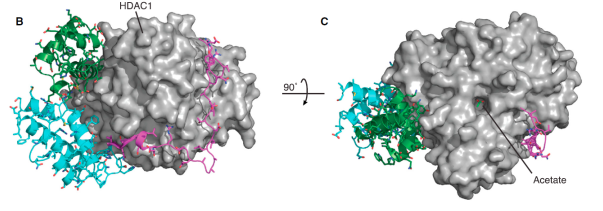Written by Professor Bryan Turner, University of Birmingham, UK
Histone deacetylase inhibitors (HDACi) are clinically effective epigenetic drugs. Two, suberoylanilide hydroxamic acid (SAHA, Vorinostat) and a cyclic tetrapeptide (depsipeptide, Romidepsin) have been approved by the US Food and Drug Administration for treatment of Cutaneous T-Cell Lymphoma. A variety of related compounds are in clinical trials against various cancers, often in combination with other chemotherapeutic agents. Short chain fatty acids have been known for many years to inhibit HDACs and the branched-chain derivative valproic acid (VPA) is widely used clinically, both as an anti-epileptic, and in clinical trials against various cancers.
A frequent criticism of HDACi is that they are relatively non-specific. It is true that most HDACi inhibit several different members of the 18- strong HDAC family and that catalytically active HDACs have multiple substrates, including various non-histone proteins. However, the situation has been simplified with the progressive realisation that only four HDACs, namely the Class I enzymes HDAC 1, 2, 3 and 8, are (1) catalytically active, (2) sensitive to currently available HDACi and (3) active in the cell nucleus (ie. likely to be involved in epigenetic events). The remaining HDACs are either insensistive to currently available, clinically relevant, HDACi (ie. the seven sirtuins), catalytically ineffective (HDAC 4, 5, 7, 9, 11) or primarily cytoplasmic (HDAC 6, 10). Crucially, the Class I enzymes are themselves catalytically active only when part of defined multi-protein complexes that stimulate their activity.
The gene-regulatory complexes of which Class I HDACs are key components have recently been purified and subjected to detailed structural analysis [1]. There are four such complexes, namely CoRest, NuRD, Sin3 and NCoR/SMRT. (The names are disconcerting, but make historical sense). The first three contain HDAC1 and HDAC2, while NCoR contains just HDAC3. The complexes are responsible for the up- and/or down-regulation of specific genes and are necessary for the correct differentiation of various cell types.
Remarkably, recent results show that the sensitivity of a particular HDAC to a specific inhibitor is dependent on the complex of which it is part. Using a clever affinity purification/inhibition approach, coupled to state-of –the-art mass spectrometry, Marcus Bantscheff and colleagues [2] have shown that HDAC1/2, when part of the CoRest complex, are inhibited by VPA with a Kd of around 0.65mM, (ie. below the maximum plasma concentration achievable by oral administration). In contrast, the same two enzymes are inhibited with a Kd of about 1.4mM in the NuRD complex, and 13mM in the Sin3 complex. Thus, there is a 20-fold difference in sensitivity depending on the complex of which the enzymes are part. HDAC3 in the NCoR complex is inhibited with a Kd of around 4mM. These observations raise the possibility of differentially affecting the function of specific HDAC complexes, and the genes they regulate, by adjusting the dosage of HDACi. Low doses, even if orally administered, will selectively target CoRest. Higher doses will begin to affect NuRD, while the highest doses, perhaps applied directly to the tumour, will also target NCoR.
Bantscheff and colleagues showed also that the ability of HDAC complexes to influence sensitivity to HDACi, was very dependent on which type of inhibitor was being tested [2]. SAHA (Vorinostat), often regarded as a superior inhibitor to VPA because it is effective at lower concentrations, inhibited HDAC activity with Kd values ranging from 0.2 to 0.4µM, irrespective of the complex. Thus, SAHA acts as a pan-specific HDACi, apparently without the potential dose-specific effects offered by VPA.
 Figure showing how MTA1, a component of the NuRD complex, interacts with HDAC1 (grey). Used with permission from [3].
Figure showing how MTA1, a component of the NuRD complex, interacts with HDAC1 (grey). Used with permission from [3].
A second important and unexpected insight from structural studies is the demonstration that for both the NCoR and NuRD complexes, optimal HDAC activity requires incorporation of a molecule of D-myo-inositol 1,4,5,6 tetrakisphosphate (InsP4) [3]. Inositol phosphates are crucial mediators of intracellular signalling pathways. It is significant that the Kd for InsP4 incorporation into the NuRD complex is around 5µM, within the intracellular concentration range, suggesting that the concentration of this important signalling molecule may be another means by which the epigenetic effects of HDACi are regulated.
It will come as no surprise to clinicians to hear that the dosage at which a drug is administered will influence its effects, nor that applying drugs in combination can be beneficial. But these structural results, and the quantitative analyses that stem from them, are important in that they give insight into the molecular mechanisms that underpin drug actions and show that the therapeutically relevant targets of HDACi are the complexes of which they are part, rather than the catalytic subunits alone.
References
- Kelly RD, Cowley SM: The physiological roles of histone deacetylase (HDAC) 1 and 2: complex co-stars with multiple leading parts. Biochemical Society transactions 2013, 41(3):741-749.
- Bantscheff M, Hopf C, Savitski MM, Dittmann A, Grandi P, Michon AM, Schlegl J, Abraham Y, Becher I, Bergamini G et al: Chemoproteomics profiling of HDAC inhibitors reveals selective targeting of HDAC complexes. Nature biotechnology 2011, 29(3):255-265
- Millard CJ, Watson PJ, Celardo I, Gordiyenko Y, Cowley SM, Robinson CV, Fairall L, Schwabe JW: Class I HDACs share a common mechanism of regulation by inositol phosphates. Molecular cell 2013, 51(1):57-67.
Follow our sister journal Epigenetics & Chromatin on twitter @EpigenChromatin
- Raising funds for genetic diseases - 23rd September 2016
- The Epigenetics and Chromatin Clinic - 9th November 2015
- Resurrecting one of the oldest genetics journals - 23rd October 2015
Comments